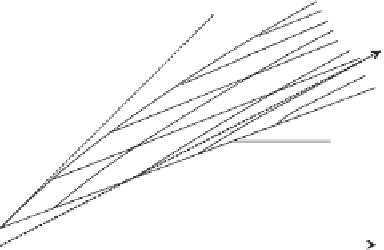Environmental Engineering Reference
In-Depth Information
where:
τ
of the earlier unsaturated soil shear strength data sets (e.g.,
Bishop et al., 1960) show a close fit to the linear shear
strength equation (Fredlund and Rahardjo, 1993a). The lin-
ear form (i.e.,
f
1
=
=
shear strength,
c
=
effective cohesion intercept,
tan
φ
b
) is convenient to use for illus-
trating the effect of matric suction on shear strength.
σ
n
=
total normal stress on the failure plane at failure,
φ
=
effective angle of internal friction, and
f
1
=
soil property function defining the relationship
between shear strength and soil suction, the deriva-
tive of which [i.e.,
df
1
/d(u
a
−
11.2.5 Shear Strength Equations at Critical State
Several critical state shear strength equations have also been
proposed for unsaturated soils (Alonso et al., 1990; Wheeler
and Sivakumar, 1995; Toll, 1990; Maatouk et al., 1995). The
proposed equations attempt to describe the shear strength of
an unsaturated soil under critical state conditions in terms
of
q-p-r
space. In general, the results show an increase in
shear strength as matric suction is increased, but the charac-
ter of the results varies among researchers. The stress state
variables used to present critical state shear strength are as
follows:
u
w
)
] gives the instan-
taneous rate of change in shear strength with
respect to soil suction (Fredlund, 2005).
Figure 11.8 shows Eq. 11.3 plotted as a three-dimensional
constitutive surface with matric suction perpendicular to the
conventional two-dimensional Mohr-Coulomb plot. The soil
properties
c
and
φ
are presented as saturated soil constants,
but the soil property
f
1
is shown as a function of soil suction
(i.e., or the amount of water filling the voids of the soil).
The form of Eq. 11.3 allows the shear strength envelope
with respect to matric suction to be either linear or curved,
depending upon the experimental test results. Shear strength
envelopes that are measured over a wide range of matric
suction values tend to show a curved shape.
Under low-suction conditions (i.e., less than the air-entry
value of the soil), the derivative of
f
1
tends to a value equal
to the tangent of the effective angle of internal friction of
the saturated soil (i.e., tan
φ
). The shear strength enve-
lope starts to become curved as the air-entry value for the
soil is exceeded. There generally appears to be a gradual
curvature in the shear strength envelope up to residual suc-
tion conditions. At high suction conditions (i.e., greater than
residual soil suction), the derivative of
f
1
has been shown
to tend toward zero for several soils with varying silt and
clay contents (Nishimura and Fredlund, 2001). Sandy soils
have shown that the slope may even become negative at
suctions greater than the residual value (Donald, 1956; Gan
and Fredlund, 1996).
A linear form of the general shear strength equation (i.e.,
Eq. 11.3) was published by Fredlund et al. (1978). Some
q
=
σ
1
−
σ
3
;
deviator stress
(11.4)
σ
1
+
σ
2
+
σ
3
p
=
;
mean total stress
(11.5)
3
r
=
u
a
−
u
w
;
matric suction
(11.6)
where:
σ
1
=
major principal stress,
σ
2
=
intermediate principal stress,
σ
3
=
minor principal stress,
u
a
=
pore-air pressure, and
u
w
=
pore-water pressure.
A general equation form for incorporating matric suction
into the critical state shear strength equation can be written
as follows:
q
=
Mf
2
(p
−
u
a
,u
a
−
u
w
)
(11.7)
where:
M
=
material characteristic independent of stresses and
f
2
=
an independent function of
p
−
u
a
and
u
a
−
u
w
.
The critical state shear strength model proposed by Alonso
et al. (1990) has the following form:
q
=
M(p
−
u
a
)
+
κ(u
a
−
u
w
)
(11.8)
φ′
where:
κ
=
soil parameter.
C
Joomi (2000) combined the net mean stress and matric
suction using the degree of saturation and suggested a sim-
ilar equation form:
Net normal stress,
σ
-
u
a
Figure 11.8
Extended Mohr-Coulomb failure surface depicted in
terms of independent stress state variables (from Fredlund et al.,
1978).
q
=
M
[
(p
−
u
a
)
+
S(u
a
−
u
w
)
]
(11.9)












Search WWH ::

Custom Search